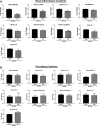Renal denervation and CD161a immune ablation prevent cholinergic hypertension and renal sodium retention
- PMID: 31172810
- PMCID: PMC6766722
- DOI: 10.1152/ajpheart.00234.2019
Renal denervation and CD161a immune ablation prevent cholinergic hypertension and renal sodium retention
Abstract
Cholinergic receptor activation leads to premature development of hypertension and infiltration of proinflammatory CD161a+/CD68+ M1 macrophages into the renal medulla. Renal inflammation is implicated in renal sodium retention and the development of hypertension. Renal denervation is known to decrease renal inflammation. The objective of this study was to determine the role of CD161a+/CD68+ macrophages and renal sympathetic nerves in cholinergic-hypertension and renal sodium retention. Bilateral renal nerve denervation (RND) and immune ablation of CD161a+ immune cells were performed in young prehypertensive spontaneously hypertensive rat (SHR) followed by infusion of either saline or nicotine (15 mg·kg-1·day-1) for 2 wk. Immune ablation was conducted by injection of unconjugated azide-free antibody targeting rat CD161a+. Blood pressure was monitored by tail cuff plethysmography. Tissues were harvested at the end of infusion. Nicotine induced premature hypertension, renal expression of the sodium-potassium chloride cotransporter (NKCC2), increases in renal sodium retention, and infiltration of CD161a+/CD68+ macrophages into the renal medulla. All of these effects were abrogated by RND and ablation of CD161a+ immune cells. Cholinergic activation of CD161a+ immune cells with nicotine leads to the premature development of hypertension in SHR. The effects of renal sympathetic nerves on chemotaxis of CD161a+ macrophages to the renal medulla, increased renal expression of NKCC2, and renal sodium retention contribute to cholinergic hypertension. The CD161a+ immune cells are necessary and essential for this prohypertensive nicotine-mediated inflammatory response.NEW & NOTEWORTHY This is the first study that describes a novel integrative physiological interaction between the adrenergic, cholinergic, and renal systems in the development of hypertension, describing data for the role of each in a genetic model of essential hypertension. Noteworthy findings include the prevention of nicotine-mediated hypertension following successful immune ablation of CD161a+ immune cells and the necessary role these cells play in the overexpression of the sodium-potassium-chloride cotransporter (NKCC2) in the renal medulla and renal sodium retention. Renal infiltration of these cells is demonstrated to be dependent on the presence of renal adrenergic innervation. These data offer a fertile ground of therapeutic potential for the treatment of hypertension as well as open the door for further investigation into the mechanism involved in inflammation-mediated renal sodium transporter expression. Taken together, these findings suggest immune therapy, renal denervation, and, possibly, other new molecular targets as having a potential role in the development and maintenance of essential hypertension.
Keywords: CD161; CD68; adrenergic; cholinergic; hypertension; inflammation; innate immunity; macrophage; nicotine; renal; renal denervation.
Conflict of interest statement
No conflicts of interest, financial or otherwise, are declared by the authors.
Figures









Similar articles
-
Nicotine Mediates CD161a+ Renal Macrophage Infiltration and Premature Hypertension in the Spontaneously Hypertensive Rat.Circ Res. 2016 Oct 28;119(10):1101-1115. doi: 10.1161/CIRCRESAHA.116.309402. Epub 2016 Sep 22. Circ Res. 2016. PMID: 27660287 Free PMC article.
-
Perivascular radiofrequency renal denervation lowers blood pressure and ameliorates cardiorenal fibrosis in spontaneously hypertensive rats.PLoS One. 2017 Apr 28;12(4):e0176888. doi: 10.1371/journal.pone.0176888. eCollection 2017. PLoS One. 2017. PMID: 28453557 Free PMC article.
-
Sympathoinhibitory Effect of Radiofrequency Renal Denervation in Spontaneously Hypertensive Rats With Established Hypertension.Am J Hypertens. 2016 Dec 1;29(12):1394-1401. doi: 10.1093/ajh/hpw089. Am J Hypertens. 2016. PMID: 27538721 Free PMC article.
-
Renal nerves and hypertension: an update.Fed Proc. 1985 Oct;44(13):2846-50. Fed Proc. 1985. PMID: 3899731 Review.
-
The sympathetic nervous system in clinical and experimental hypertension.Kidney Int. 1986 Sep;30(3):437-52. doi: 10.1038/ki.1986.204. Kidney Int. 1986. PMID: 3537449 Review.
Cited by
-
Actions of immune cells in the hypertensive kidney.Curr Opin Nephrol Hypertens. 2020 Sep;29(5):515-522. doi: 10.1097/MNH.0000000000000635. Curr Opin Nephrol Hypertens. 2020. PMID: 32701602 Free PMC article. Review.
-
Report of the National Heart, Lung, and Blood Institute Working Group on Hypertension: Barriers to Translation.Hypertension. 2020 Apr;75(4):902-917. doi: 10.1161/HYPERTENSIONAHA.119.13887. Epub 2020 Feb 17. Hypertension. 2020. PMID: 32063061 Free PMC article. Review.
-
Neuroimmune Interactions and Their Role in Immune Cell Trafficking in Cardiovascular Diseases and Cancer.Int J Mol Sci. 2025 Mar 12;26(6):2553. doi: 10.3390/ijms26062553. Int J Mol Sci. 2025. PMID: 40141195 Free PMC article. Review.
-
Possible organ-protective effects of renal denervation: insights from basic studies.Hypertens Res. 2023 Dec;46(12):2661-2669. doi: 10.1038/s41440-023-01393-w. Epub 2023 Aug 2. Hypertens Res. 2023. PMID: 37532952 Review.
-
Decreased 11β-Hydroxysteroid Dehydrogenase Type 2 Expression in the Kidney May Contribute to Nicotine/Smoking-Induced Blood Pressure Elevation in Mice.Hypertension. 2021 Jun;77(6):1940-1952. doi: 10.1161/HYPERTENSIONAHA.120.16458. Epub 2021 Apr 5. Hypertension. 2021. PMID: 33813843 Free PMC article.
References
-
- Banek CT, Gauthier MM, Baumann DC, Van Helden D, Asirvatham-Jeyaraj N, Panoskaltsis-Mortari A, Fink GD, Osborn JW. Targeted afferent renal denervation reduces arterial pressure but not renal inflammation in established DOCA-salt hypertension in the rat. Am J Physiol Regul Integr Comp Physiol 314: R883–R891, 2018. doi:10.1152/ajpregu.00416.2017. - DOI - PMC - PubMed
-
- Banek CT, Knuepfer MM, Foss JD, Fiege JK, Asirvatham-Jeyaraj N, Van Helden D, Shimizu Y, Osborn JW. Resting afferent renal nerve discharge and renal inflammation: elucidating the role of afferent and efferent renal nerves in deoxycorticosterone acetate salt hypertension. Hypertension 68: 1415–1423, 2016. doi:10.1161/HYPERTENSIONAHA.116.07850. - DOI - PMC - PubMed
-
- Billerbeck E, Kang YH, Walker L, Lockstone H, Grafmueller S, Fleming V, Flint J, Willberg CB, Bengsch B, Seigel B, Ramamurthy N, Zitzmann N, Barnes EJ, Thevanayagam J, Bhagwanani A, Leslie A, Oo YH, Kollnberger S, Bowness P, Drognitz O, Adams DH, Blum HE, Thimme R, Klenerman P. Analysis of CD161 expression on human CD8+ T cells defines a distinct functional subset with tissue-homing properties. Proc Natl Acad Sci USA 107: 3006–3011, 2010. doi:10.1073/pnas.0914839107. - DOI - PMC - PubMed
-
- Brissette-Storkus CS, Kettel JC, Whitham TF, Giezeman-Smits KM, Villa LA, Potter DM, Chambers WH. Flt-3 ligand (FL) drives differentiation of rat bone marrow-derived dendritic cells expressing OX62 and/or CD161 (NKR-P1). J Leukoc Biol 71: 941–949, 2002. - PubMed
Publication types
MeSH terms
Substances
Grants and funding
LinkOut - more resources
Full Text Sources
Medical

